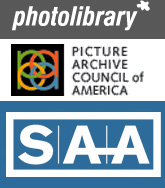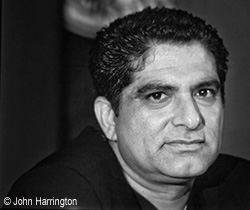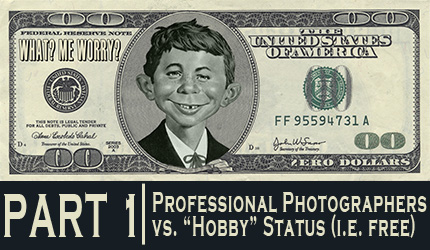 It continues to be a head-shaker for me that the purveyors of stock can take such a disdainful position towards the actual people making the images. They seem to not realize that without those that produce the images, they have empty filing cabinets and idle servers with nothing to sell or license.
It continues to be a head-shaker for me that the purveyors of stock can take such a disdainful position towards the actual people making the images. They seem to not realize that without those that produce the images, they have empty filing cabinets and idle servers with nothing to sell or license.
First up is Photolibrary(PL), and one of the companies they acquired - Index Stock. What doesn’t seem to be in dispute is that Index Stock had money problems and was possibly going bankrupt. When Photolibrary purchased Index Stock, they didn’t do so in bankruptcy, and further, didn’t do so with any attempt to preclude assuming all of Index Stocks’ debt, and there remain large portions that still need to be paid. What is in question is if PL acted ethically and honestly with regard to the debt. While I don’t have answers, per se, to those questions, I do have some insights that are worth sharing. If any of the accusations are true, this puts in question whether PL is run by ethical people at all.
We received numerous internal PL documents from sources, which detail the behind-the-scenes maneuvering regarding PL, PACA, and the thousands of photographers who have not been paid for the use of their work.
(Continued after the Jump)
When PL acquired the stock agency Index Stock in October of 2006 (as announced here), not only did they acquire the entire collection (whether wholly owned images or the right to continue to license the images of photographers that were represented by Index Stock) but they also acquired the accounts receivable (i.e. the money that people who had licensed images from Index Stock but had not yet paid) as well as the accounts payable (i.e. the money that Index Stock had collected for image licensing but had not yet paid to the photographers whose work was licensed).
After about a month on the job, a Controller hired by PL, after having had an in-depth look at the accounting systems, found information and documents that appeared to point to massive potentially illegal and unethical activities on the part of PL leadership. At the time, the Controller determined his best course of action was to become a “whistle blower.” He wrote an e-mail outlining the problems and blasted it out to hundreds of PL photographers along with detailed individual statements of what they were owed, as reported on by Photo District News here – “Letter To Stock Contributors Is Instant Classic”.
The Controller also sent substantial documentation and information to the Picture Archive Council of America (PACA) and the Stock Artists Alliance (SAA) asking for their help in getting the contributors paid, and in bringing PL’s accounting practices to light.
SAA tried to engage with PL directly but after they were dismissive of the allegations and unresponsive, SAA issued a press release that laid out their detailed concerns that “about whether Photolibrary has met its contractual obligation to pay Index Stock contributors all past commissions.” ( read here).
A week later SAA was joined by the American Society of Media Photographers (ASMP), Advertising Photographers of America (APA), Editorial Photographers (EP), and the Canadian Association of Photographers and Illustrators in Communications (CAPIC) calling on PL to “seek full accounting and payments of any monies owed to contributors”, according to an SAA press release.
Four days later, PL issued their own press release, where they characterized the Controllers' e-mail as containing “inaccurate and ill-founded reports in the media and elsewhere, drawing on unauthorized and misleading information”. The controller was summarily fired days later.
At the request of PACA following inquiries by the whistle blower about filing a grievance, he handed over further evidence and documentation and wrote in his grievance that he would testify in court to the validity major accusations of:
1. PL’s attempt to write off 2 million dollars they knew was supposed to be paid to photographers for the images that clients licensed, on their 2006 tax forms. Internal emails from PL’s CFO John Smith directed the whistleblower to alter tax forms to move the 2 million from debt obligations to misc income, seeming to subvert the monies that should be paid to the photographers whose images generated that revenue. Attached to this email was PL’s Tax form supposedly in the handwriting of John Smith directing the change.
2. A PL email from Tim Moore ordering employees to tell artists that KPMG completed an audit and all past debt was paid. PL now states that the audit was not complete, but KPMG clearly wanted to distance themselves when they told SAA “KPMG LLP (US) was not engaged to perform an audit or review of any financial statements of Photolibrary”, as reported here at Photo Archive News.
3. PL incorporating an applet in their Australian accounting system that purposely under-reports 20% of sales. If true, this action affects all PL photographers and distributors, even those outside of Index Stock.
4. PL was accused of knowingly selling out of contract images and purposely keeping all revenue. This is something no one has talked about to this point.
Re-enter Stock Artists Alliance. SAA has been all over the Index Stock debt that PL acquired with the purchase of the company in late 2006. SAA's principal obligation is to protect the interests of rights holders, and they have been a champion of those issues from the beginning. As a part of SAA’s last investigation, 9 months after PL stated most artists were paid all or part of their debt, SAA contacted 93 of the top 400 highest grossing artists using PL own records and most had still not been paid (or even contacted) on the past debt. If PL is not paying their highest grossing artists on their own after two years, then who are they paying? After SAA’s sustained public pressure, it appears many artists are now being paid.
PACA's Grievance
Here is where the story gets murky, so I scheduled a call with Cathy Aron (LinkedIn: Profile), the Executive Director of the PACA. What we found was that she had invited their lawyer, Nancy Wolff (LinkedIn: Profile) onto the call “just to be sure I don’t say anything I shouldn’t”, said Cathy. That would make sense, especially since we have heard from more than one source that she is privately appalled at the whole Photolibrary situation. During our call, Aron, who I’ve worked with on other issues, was all business, and any allusions to her private sentiments were not in evidence.
PACA has a grievance process, whereby someone who has a problem with a member company can bring a grievance to PACA, and PACA will work to resolve the problem, saving everyone lawyer fees, and lots of hassles. Since PACA has no legal position, it’s more of a courtesy than anything else. According to Aron, “The process is in our operating manual, and if a formal complaint comes in and contacts the member, they have six weeks to decide whether it should be investigated or not.“ Aron continues “The most PACA can do is ask for a meeting. We don’t have the authority to audit. It’s sort of an informal free mediation,” and concluded “All we can do is take a complaint and present it to our agents. “
What kind of grievance would occur? The most common one is when a photographer under contract with a PACA member, determines that the member company has either failed to report sales and thus, pay the photographer, or the sales have been reported, but no payments have been made. While there may be others, these are the most likely to come before the PACA Grievance Committee.
PACA has, in the past, facilitated grievances that have resulted in a member company being expelled from the organization. When I asked how many, Aron responded “Two that I know of, since I’ve been involved, which has probably been fifteen years.”
PACA may be taking a lackadaisical approach to resolving the problems with Photolibrary (PL), and the non-payments of Index Stock.
Photo District News, a year ago, wrote - PACA Investigating Ethics Complaint Against Photolibrary - based on information sent from the whistle blower, yet that investigation, a year later, still remains open. Just as SAA is looking out primarily for individual rights holders, PACA's principal obligation is to the photo archives (formerly referred to as photo agencies). PACA’s Mission Statement (as seen here on their website) that lists as item #1 “To develop useful business standards, and promote ethical business practices”. Yet their actions as it pertains to the PL issue and their delays in responding to complaints (or even a resolution) suggest perhaps an unwillingness to resolve the PL issue once and for all.
10 months ago, PACA received evidence, testimony and alleged internal PL documents from the whistle blower, as well as SAA’s separate 6 page grievance detailing dates of artists statements, payments and other evidence showing vast portions of PL’s PR defense and many private statements to SAA to either come across as false or be flat-out false. Included in SAA's grievance are artists who PL had accurate contact info that had new sales record in 2007 over the $250 threshold yet never receive payments at the time. This would suggest PL recorded new sales but selectively paid artists.
Now to the conflicting obligations, with SAA serving photographers and image producers, and PACA serving the photo archive/photo library community. SAA’s last PR offered compelling evidence that that the majority of artists never received their past due debt after 9 full months. There is no public evidence that PACA responded or acted on the grievance against their member company, nor has effected payments to photographers, yet still they remain solid in the belief that PACA’s procedures are comprehensive.
What remains to be known (among many answers that should still be forthcoming) is what did PACA actually do?
At the helm of PACA's grievance committee during the grievance being raised, and current Vice President, is Christina Vaughan (LinkedIn: Profile), founder of Image Source. Interestingly, a search of PL's web site reveals that Image Source is in business with PL with over 70,000 images that are currently offered for licensing on the PL web site. As the owner of Image Source, Vaughan’s livelihood relies at least in part on payments received from PL – the very company that Vaughan has been charged with investigating, Can you say “CONFLICT OF INTEREST?”
One does not need to dig too much deeper to understand why PACA hasn’t been critical of PL. While the proceedings of the grievance committee are supposed to be confidential, some sources suggest that the board was well aware of much of the details surrounding the grievance. That said, a majority of the board members don't seem likely to be critical of PL, since many members' companies have business relationships with PL. Getty Images (Photographer's Choice, PhotoDisc, Digital Vision, Footage, Stock Byte); Jupiter Images (Banana Stock, Comstock, Creatas, Brand X, Botanica, etc) ; UpperCut Images (approx. 5,000 images); and Corbis (over 145,000 images). Of note Patrick Donehue of Corbis was president of PACA last year during the initial "investigation”.
Other PACA leaders - committee heads – with Blend Images, with over 4,400 images; Grant Heilman (via Index Stock); Look Photography, and others also have images on the PL platform. Thus, it would seem that the deck is indeed stacked in favor of PL. So sure of a positive outcome, PL CEO Tim Moore, according to sources, is reported to have said “I made her [Christina Vaughn] several million dollars last year, I’m not worried.”
So, could the PACA board act separate from the interests of the companies that employ them? We put the question to Aron, and she said that sometimes the board members wear “their PACA hat”, and other times, their employers’ hat, and that sometimes they vote in a manner that is right for PACA, but not best for their employer. She emphasized her belief in the boards’ ability to be impartial “I feel that if someone felt they couldn’t be fair, they wouldn’t vote, but it didn’t come to the board”, said Aron. And therein lies the problem.
The grievance never made it to the board, because the Grievance committee headed up by Christina Vaughan at the time. While the grievance board's other members are supposed to be confidential, according to sources, the two other members are reported to have been Jeff Schultz of Alaska Stock, and Miles Gerstein of Uppercut Images. They collectively seem to have decided that the SAA grievance did not meet the test of a valid grievance.
Come again?
So, we put this question to Aron. Regarding Photolibrary “We had several photographer complaints, and a complaint from SAA”, she said. “There’s no complaint from an association, it can only be from a photographer of an agency.” She went on “The problem with that, is the SAA, as an association - it doesn’t make sense for an association to file a complaint. “
We then talked to Betsy Reid (LinkedIn: Profile),, Executive Director of SAA. “PACA describes its grievance process as set up to investigate any complaints made against their members regarding violations of the PACA Code of Ethics. That’s precisely what we asked them to do in the case of Photolibrary. We filed a grievance to ask for their help in addressing serious allegations made against one of their most prominent members, and we provided ample information, documentation and specific examples to establish the validity of the allegations. Clearly, this was an unprecedented case for both our associations, and a challenge to PACA’s grievance process which we expect had previously dealt with more easily handled individual complaints.”
According to Aron, SAA was told “Come back with individual photographers, and we can bring those issues to the member” yer in their grievance SAA delivered a spreadsheet listing over 1,000 photographers and distributors (including PACA members) to PACA, many with contact information, and all of whom, to varying degrees, were allegedly not paid by PL, but that wasn’t good enough. The defense then turned to “There’s no signed complaint from any of those photographers, we can’t just use names on a spreadsheet” Aron said during our call. Yet we have reviewed several emails and written letters addressed to Aron and PACA’s ethics board clearly from individual photographers. To date, none of them have received a response to their e-mails, but somehow, they were finally paid.
“It’s a learning process for us too. We’ve never had a situation like this before, and we had to go back to our bylaws”, said Aron.
Could Vaughan of Image Source be impartial in this PACA investigation/inquiry/grievance?
We asked Aron, and she said “We had asked Christina If she could handle the possible conflict of interest, and she assured us that she could.“ PACA Attorney Nancy Wolff commented during the call that she kept an eye on the proceedings, and felt that it was being pursued. So, the question remains – is there a grievance, or isn’t there? According to whatever was investigated, Aron’s stated position on Vaughan was clear “She treated it with no bias.”
“We were monitoring this because it was such a huge issue, and the few photographers – the last thing we heard from Christina was, after her meeting with SAA in New York - she never heard from SAA with individual photographer names” said Aron. Wolff reiterated “We requested specific photographer issues to be dealt with, and we never heard back. It’s back in SAA”s lap.”
SAA’s 2007 President Roy Hsu (LinkedIn: Profile) was at the New York meeting with Vaughan and stated in response, "Christina was our sole source of contact and this is the first time I have heard that SAA's grievance did not qualify. Christina repeatedly referred to our document as a grievance, and repeatedly promised a written response in our New York meeting. We stated that SAA's intention was only to see that PL fulfilled their contractual obligations which we felt, given the massive information passed to PACA, was not happening. Christina agreed and confirmed that PACA had put PL on a ‘watching brief’. She asked us to submit a clarified 3 to 5 questions for PACA/PL to directly respond to and end this case, which we promptly provided in an email and never received any response. At that point, we decided that the process did not produce much fruit and moved forward to contacting artists directly and keeping our focus on getting everyone paid.”
With many of the leadership of PACA (in the form of the companies that employ them) having a financial interest in PL, continuing whatever methods of revenue collection they have, and maintaining a good reputation for PL, it is understandable (but not acceptable) that they would want to maintain the status quo, if that is, in fact, what they are doing. While Aron stated emphatically on the call as it regards the grievance “it’s confidential, and doesn’t go to the board. The only reason it would go to the board, is if there was a recommendation for expulsion”, yet sources suggest that the board was well aware of the allegations.
So what were the actions of Vaughan?
In Vaughan's member update dated 5/22/08 she states that the PACA grievance procedures are to expulsion, probation or dismissal of complaint. " In all cases, copies of the decision shall be furnished to both parties." This is required within 6 weeks, and Vaughan’s correspondence with the whistle blower suggests she was treating the complaint as falling within the guidelines of a valid PACA grievance when she noted to him via e-mail “As per our Protocol, I have 6 weeks to examine the case and report back to the Board”. Yet she has yet to respond to the whistle blower of the outcome of probation, dismissal or expulsion. In an email sent to him, she only stated that PL is on a "watching brief", which would imply that Vaughan at a minimum acknowledged wronging by PL.
As part of Vaughn's 'comprehensive' investigation, she never once talked to the whistle blower over the phone, and she limited her communications to several emails that were initiated by him. When she asked for all the evidence, she then handed all of it to PL, stating that that was a part of the grievance procedures, so that PL could provide comment. While resolving a dispute over a sale or a minor contractual issue would require such an action, it is rather odd that someone would hand over all the evidence of alleged serious financial fraud over to the defendant for a response. PL created their Dec 2007 PR ”separating fact from fiction”, which was a point-by-point response to the accusations and evidence handed them by Vaughan. This response was a part of a PDN article “Photolibrary Explains Index Stock Problems, Calls Reports "Inaccurate", and they issued a five page statement defending themselves, readable here.
Vaughn’s statement to PACA members could well come across as misleading to the many honest PACA members, and could have been properly adjudicated within PACA’s guidelines, or, if not, given the alleged widespread non-payment (and alleged under-payments by 20%) treat this situation as a special circumstance and handle all the issues in a similar format that a class action lawsuit might be handled. I can’t square what has happened, to date, with any fair and thoughtful interpretation of PACA’s bylaws. It would seem that, at best, Vaughn ignored the entire situation, at worse could be complicit and aided PL in their defense.
Many times the truth lies in middle and sadly in this case If only a fraction of these allegations are true, PL leadership could easily be seen by many as unethical. If the extent and evidence of the PACA grievances filed is not enough to raise the real possibility of expulsion based upon timely actions by PACA’s board, what does a PACA member need to do?
In the end, what does this mean to other PL contributors outside of Index Stock?
Current artists payment statements can only be considered correct if you believe that PL is and has run an honest business. In this business where artists and distributors have to rely on the honesty of major distributors like PL, that honesty appears to broken, whether by accident or nefarious action, and that distinction remains to be seen. Is anyone sure that they aren't only receiving a fraction of the sales due them? Even the many companies that are represented on the board of PACA?
One of the big questions is whether or not current PL statements are in fact accurate. Despite a PL letter to artists stating KPMG was hired to perform an audit, PL now states it was incomplete, and KPMG went out of their way to stipulate that they never performed an audit, as noted above “when they told SAA ‘KPMG LLP (US) was not engaged to perform an audit or review of any financial statements of Photolibrary' ". Only if PL artists, and distribution partners come together for a real and formal audit can anyone really be sure. And it should be a formal audit looking for the sundry accounts and exonerating any charges of unlawful activities as claimed by the whistle blower to PACA.
Steps for Photographers, Distributors and PACA Members not yet Paid:
Aron noted “We want everyone treated fairly, and to be paid and that seems to be happening.” She went on “Individual photographers who filed a complaint – the case was closed and they’re happy.” And she stated “The offer still stands for any SAA photographers - if things haven’t been taken care of, we’re happy to look at their complaint.”
So, if you are among the 1,000+ photographers and distributors who have allegedly not been paid, PACA is more than happy to hear from you, and more than happy to look at your complaint. A group complaint about an alleged pattern of wrongdoing by one of their members isn’t something that PACA has the bylaws to cause a member to be considered for expulsion. As far as what you’ll need to provide to PACA - They’ll want a copy of your contract, and any other information you have pertinent to your claim.
For the most immediate results we would recommend the following:
1. Provide contract or information
2. Provide information regarding your situation (outstanding debt, withdrawn images still being marketed, etc) SAA is likely more than happy to provide you with a copy of the evidence they have specific to you.
3. Email PACA (and cc’ing SAA couldn’t hurt) with the complaint will probably expedite things like the photographers who initially contacted them and listed in their grievance.
You can contact Cathy Aron at PACA at execdirector@pacaoffice.org, and CC the current grievance chairperson Laura Dives at ethics@pacaoffice.org. Whatever you write to them, you might also want to CC to SAA’s Executive Director Betsy Reid, at: Betsy@stockartistsalliance.org, and SAA has more information about PL at this link.
To date, Photolibrary remains a “member in good standing” at PACA.
Please post your comments by clicking the link below. If you've got questions, please pose them in our Photo Business Forum Flickr Group Discussion Threads.[More: Full Post and Comments]
 My issue of Picture Magazine arrived today, and at the end of the issue is a piece by consultant Selina Maitreya about affirmations, so I thought I'd take a minute to use the article as a jumping-off point to discuss the notion of affirmations as we depart 2008 and prepare for 2009.
My issue of Picture Magazine arrived today, and at the end of the issue is a piece by consultant Selina Maitreya about affirmations, so I thought I'd take a minute to use the article as a jumping-off point to discuss the notion of affirmations as we depart 2008 and prepare for 2009.















